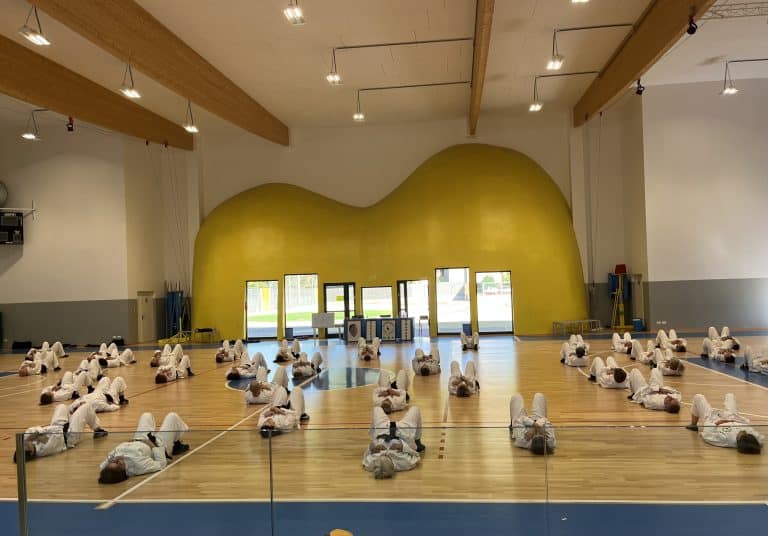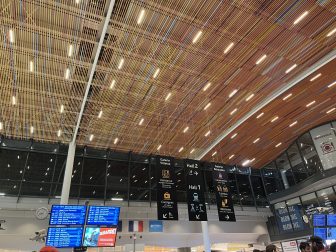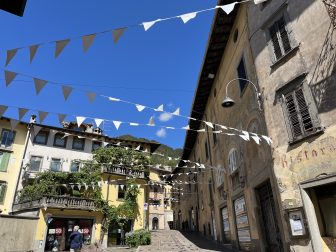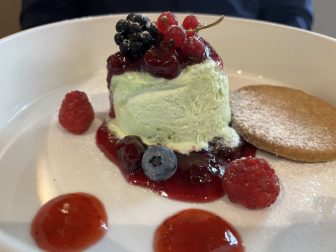
(This is my husband’s post.)
[Aug.2025] I spent three days in Clusone, a beautiful town in the Seriana Valley, Italy, just a few kilometres from Bergamo, to take part in a tai chi workshop.

Since I live about an hour and a half away by car, I decided to travel there every morning and return home in the evening after the classes instead of staying there like other people did.
It was my first experience of this kind: I’ve been practising tai chi for just over a year, but the atmosphere and organisation really impressed me.
I’ve already decided to take part in more events organised by my school.
On the first day I arrived at Clusone’s sports hall, which I had never visited before, even though I already knew the town.

Our class started at 10 a.m. and lasted about two hours; before us there had been a session for black belts and instructors.
There were about eighty participants from different regions of Italy, some even from Apulia.
The event was also attended by Master Ignazio Cuturello, the national head instructor, which gave the workshop a particularly important tone.
After finishing the class around noon, we went for lunch at the nearby Casa dell’Orfano, a place rich in history and humanity.

The Casa dell’Orfano Mons. Giovanni Antonietti was founded in 1925 to welcome war orphans and provide them with moral and material support.
Over the years, the structure expanded to become a real village surrounded by pine trees, with a church, school, refectories, workshops and dormitories.
Its sober and functional architecture reflects the educational spirit of its founder, who saw work, culture and solidarity as the pillars of a young person’s growth.
Today, the complex hosts a foundation, a museum, a library and several spaces for social and cultural activities.
Lunch was simple and genuine, prepared by local volunteers.
We sat at two long wooden tables in an atmosphere of friendliness and warmth.
In the afternoon, the master organised a guided tour of Clusone’s historic centre.

Our guide, a knowledgeable young local, led us through the old streets to the Oratory of the Disciplini, home to the famous Dance of Death (Trionfo della Morte) fresco from the 15th century a masterpiece symbolising the equality of all before death.
The fresco stands beside the Basilica of Santa Maria Assunta, one of the main religious monuments in the Seriana Valley.
I must admit that the guide’s explanation, though very interesting, was a little too long, we stood in front of the fresco for almost half an hour.
We then visited Piazza dell’Orologio, the heart of the town, featuring the famous Astronomical Clock by Pietro Fanzago, built in 1583.

It shows not only the time but also the zodiac signs, lunar phases and the sun’s path.
During the walk, we also learned the curious story of the two giant sequoias imported from North America and planted in Clusone’s public gardens, a true botanical rarity.
After the tour, we returned to Casa dell’Orfano for a two-hour class on Chinese calligraphy, again led by Master Cuturello.
It was my first time, and I found it truly fascinating.
The next day followed a similar schedule: tai chi in the morning, calligraphy in the afternoon, and after lunch, a guided tour inside Casa dell’Orfano.

This time the guide was a local man with great enthusiasm, who accompanied us through the different buildings: the Casa Madre, the Suardo Pavilion, the old infirmary, the Church of Christ the King with its frescoes, and the pavilions that once housed the children.
Each area told the story of everyday life for the hundreds of young people who grew up there, a place combining discipline, faith and affection.
Walking through those corridors was moving: you can still feel the atmosphere of a living, hard-working community, a symbol of an important era in the history of the Seriana Valley.
On the third day we had only the morning training session, and we were free from lunchtime onwards.
My wife had accompanied me from the start that day and stayed to watch the class.
It was the first time she had seen me practise, and she said it was interesting to finally see what I’ve been learning.

After the official closing of the workshop, we treated ourselves to lunch at an excellent restaurant in the centre of Clusone that we already knew and had greatly enjoyed on previous visits, the perfect way to end three days full of learning and discovery.



